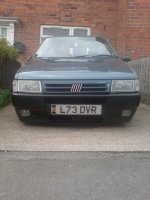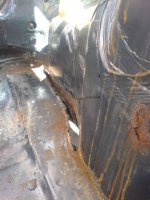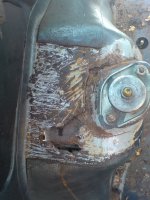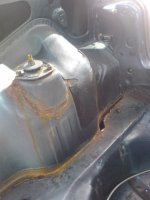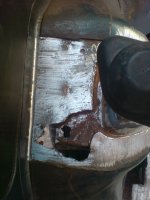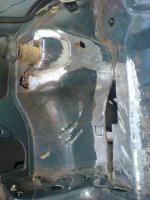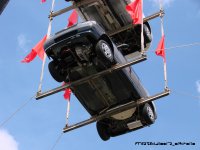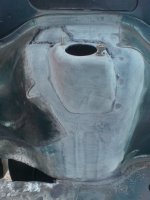It's actually all relative. We've seen Unos with far more rust than that... there have been cases where the whole width of the tyre tread shows through rust holes in the rear turrets...
Now, most Unos are about 20 years old, so they're doing well compared to those 70s cars. But it's frustrating when the steel basically rusts from the inside out... Yet sometimes the worst rust seems to just start from within seams that are dry.
I believe some of it is down to how the steel is made (I was told by a production manager, not from FIAT). The furnaces of the steelworks (e.g. at FIAT) had oxygen added to help the fires burn brighter and more efficiently for a given amount of fuel. This extra oxygen ends up in the steel - pre-oxidised steel = pre-rusted steel. Whether that is true or not, I don't know for sure. I just know that some steel seems naturally more rust-prone than other steel. Uno body steel seems very rust-prone. Therefore if the paint/protection is breached, it rusts.
And in some cases, I wonder if the rusting has already started by the time the paint/protection goes on at the factory. Nothing less would explain the extreme rusting I've seen ravaging certain panels under the paint, e.g. Mk2 Uno doors, where one skin has a huge rusted hole, yet the frame it attaches to is pristine. If the rust was starting due to trapped water (as you might expect in the bottom of a door) then both skins would have rusted to some extent.
Look at some Japanese cars, particularly those you receive as imports direct from Japan - no underseal at all and no wax in the doors!
Realistically the only thing FIAT could have done better was to use actual galvanised steel, which they did on the Tipo and apparently models since then (but who really knows what a Mk2 Punto will look like in 15 years...

I personally suspect that the effort may lapse again; it may go in cycles...)
-Alex
The Tipo & Tempras werent completely galvanised either, if you look at the literature at the time, it says "100% galvanising of the
external steel", in other words, it`ll look pretty longer, but still die of rust in 10-15 years!
Also, the underseal used is constantly bombarded with stones & things you run over, when its fresh, it is resilient & waxy, after 5-8 years, it looses its oily nature & starts becomming brittle, meaning the areas that get bombarded, vanish, then create "underseal pockets" that water creaps under & causes rust faster than it would if it had no sealing at all!
Rust also doesnt tend start in the middle of a flat sheet of steel, it tends to start at joins or places where mud builds up. welded seems are usually the worst & are pretty much untreatable after a few years... Remember, galvanised panels have to have the zink stripped off (& weld thru seem sealer applied, which starts to deteriorate after 6-10 years) when they are welded, or the weld doesnt take place.
Its not only Fiat, my 10yo Jaguar XJR that cost around 10 times more than a Punto when new has more rust than my 20yo Daimler despite having fundimentally the same shell, mainly for 2 reasons, 1, when the shell was modified to take the V8 engine & subframe, they relocated the NSF brake pipe, creating a mud trap, & 2. where the chassis legs were modified to fit the V8 subframe, they made it 3 layers thick, making it almost impossible to rustproof & its right next to the mud trap brake pipe...
Its also suffered more from stone chipping round the arch lips because of the weaker water based paint used & they also used slightly thinner steel on the XJ8 to reduce weight to meet stricter economy requirements...
I`ve also seen rust on 5yo VW`s, Merks, BM`s & Audi`s recently, cars that 10-20 years ago were the leaders in building cars that
didnt rust....
My 1993 Tempra has rusted in the following places despite the galvanising:
Outer edges of the floors where they join the inner sills (mainly to the drivers corner as my Dad jacked it wrongly about 5 yrs ago, which disrupted the paint, but the whole length of the sills on both sides had surface rust under the underseal)
Boot floor where it joins the rear panel behind the spare wheel well
Top corner of the NSR boot window (due to dirt build up behind the plastic gutter, both sides then removed, treated & rustproofed)
Bumper bracket extensions at the front & rear corners (just surface rust)
I`ve now treated these places [& welded the drivers floor edge] & have been inspecting & treating it annually over the last few years, also any sign of damage to the underseal has been locally scraped of, treated & re-undersealed.
My 1990 Uno is remarkably rust free, I`ve been all over her & the only signs are a 1mm bubble on the front wing an inch away from the sill & rust staining on the triangular gussets (what a lovely word!) between the inner wing & slam panel.
This summer, I`ll be stripping the Uno`s interior, carpets, bumpers & front wings & underseal, cleaning it, treating where nessicary & re-rustproofing the whole thing.
This might seem like overkill, but when a car that has a reputation for rusting has managed to last a decade longer than it was expected to, isnt it worth spending a few days prepairing it for yet another decade? I think so!

Also, you say about Japanese imports not having any rustproofing, this is correct, when you look at Brazilian (see picture below of a Mk4 Uno) & Indian Fiats they also dont have any rustproofing. This is fine, they have much dryer climates than us & dont use salt to prevent ice on roads during winter, this is the main reason why cars in the UK rust so badly.
I think the Punto`s WILL last better from what I`ve seen, I regulary see 15yo Punto Mk1`s with no rust thanks to much smoother design & clutter free undersides, any rust tends to be the result of badly repaired damage.
 ......except the errr, whats that unos dont have often? o yeah remember now....the floor.
......except the errr, whats that unos dont have often? o yeah remember now....the floor.

